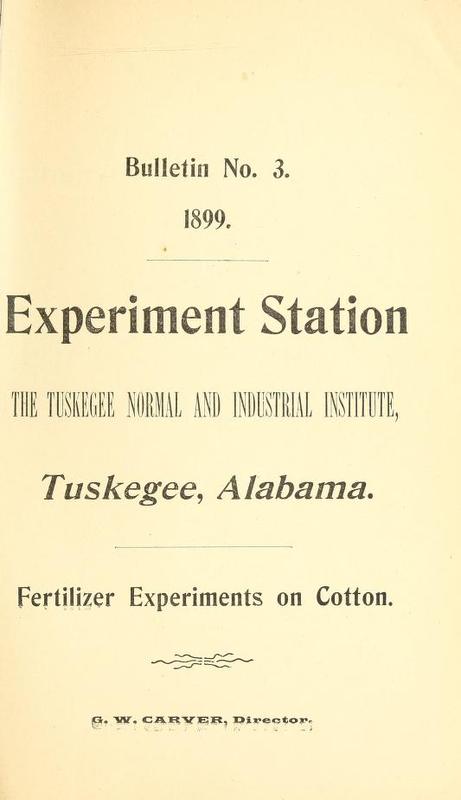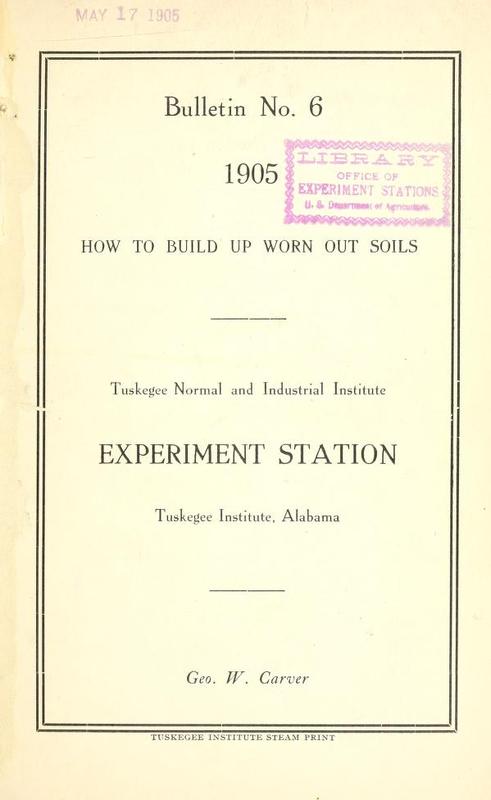Tuskegee Institute Soil Studies
Many of the standard practices of scientific agriculture were sound in theory, but could not possible be duplicated by impoverished sharecroppers and tenant farmers. Partly by intention and partly because of existing limitations. Carver’s station became more of ‘little man’s station’ than others. Even though his experiments were aimed at all levels of farming, Carver spent significantly more time on projects that required hard work and the wise use of natural resources rather than expensive implements and fertilizers.
For example, Carver selected one acre of the poorest land in the experiment station fields for a soil-building experiment. Using good cultivation practices and rotating between soil enriching plants like cowpeas and velvet beans, he was able to increase dramatically the productivity of the soil without heavy use of commercial fertilizers. In 1897 the yield of the one-acre plot resulted in a net loss of $2.40, but by 1903 Carver was able to produce a net gain of $94.65 from the same acre. The results of that experiment were published in 1905 as Bulletin 6, How to Build Up Worn Out Soils. The bulletin stated that the experiment was conducted ‘keeping in mind the poor tenant farmer with a one-horse equipment’ and that ‘every operation performed has been within his reach.’
Hines, L.O. (1979). "George Washington Carver and the Tuskegee Agricultural Experiment Station." Agricultural History, 53(1), p. 78. Retrieved from https://www.jstor.org/stable/3742861.
(Click any image in this exhibit to get more information, including access to full text)
"The cotton fertilizer experiments made in 1898 are a continuation of a series of fertilizer soil tests commenced in 1897. The soil of the experimental field, a part of the station farm, is a light and sandy upland, with yellow clay subsoil.
The soil selected is excellently adapted for experimental purposes, having formed part of an old field which has been planted by the wasteful methods of the tenant system, year after year, for a long period. The soil was thoroughly “worn out’' as to its supply of fertilizing substances, nitrogen potash, and phosphoric acid, and was also in very bad physical condition. Its humus had long since been totally worked out and the top soil was very thin and with very little power to retain moisture. Even cow-peas failed to make a fair growth, on this soil before these experiments were begun, which is a pretty sure sign of a soil practically exhausted."
"The subject of soil improvement through natural agencies has been one of much concern to both ancient and modern agriculturists.
The ancient Egyptian knew that if he let his land lie idle, (rested) as he termed it, he was able to produce a much better crop, and that crop would be in quantity and quality, all other things being equal, proportionate to the length of time this land had been rested.
At a later period the fertilizing value of legumes (pod bearing) plants was recognized, but as the population of the world increased and civilization advanced, it became imperative that all farming operations should become more intensive and less extensive.
Each decade saw the progressive farmer slowly but surely moving on his journey of progress, correcting many mistakes of the past.
He then began to see that it was quite possible and practicable to keep his ground covered with some crop, and the soil become richer and more productive every year, by reason of this constant tillage — than was possible under the old and extravagant method of letting the land lie out idle for a few years.
'As science shed light upon his art,' he learned that chemical analysis of the soil, alone (though skillfully done) did not accurately determine the crop-yielding capacity of the soil, and that the greatest good would result only when such analyses were followed by carefully conducted field experiments. From these he learns further that the crop-yielding power is increased by rotating or changing his crop every year, or every few years upon land not occupied by such crop the year previous.
For eight years the Tuskegee station has made the subject of soil improvement a special study, emphasizing the subject of crop rotation, deep plowing, terracing, fertilizing, etc., keeping in mind the poor tenant farmer with a one-horse equipment; so therefore, every operation performed has been within his reach, the station having only one horse."
"LOCATION AND BOUNDARIES
Macon County, 'the garden-spot of Alabama,' lies near the eastern boundary of the State, about 135 miles north of the Florida-Alabama line. It has an area of 621 square miles, embodying 397,440 acres. It is 34 miles in extent from east to west, and 24 miles from north to south. The northern and western boundary lines are quite irregular.
COUNTY SEAT
Tuskegee, the county-seat, was laid out in 1833, and has grown steadily since the removal of the Indians in 1836. It is located in the north central part of the county, and is noted for its commanding location, beautiful surroundings, and the purity of its waters. Indeed, mineral water of no mean composition has been found here and there within its borders.
HISTORY
Macon County was named in honor of the illustrious North Carolina statesman, Nathaniel Macon, and was established as a county December 18, 1832, by act of the General Assembly of the State of Alabama."
"Origin of Scientific Agriculture
One is not only surprised but astonished to learn that less than a century and a half ago, agriculture was without a scientific working basis. Credit goes to the great German chemist, Justus von Liebig for starting this revolutionary movement. The following four laws which form the foundation of modern agricultural practice were fully established by Liebig and should be studied and mastered by everyone attempting to deal with the fertility of the soil:
1. A soil can be termed fertile only when it contains all the materials requisite or necessary for the nutrition of plants in the required quantity and in the proper form.
2. With every crop a portion of these ingredients are removed. A part of this portion is again added from the inexhaustible store of the atmosphere; another part is lost forever if not restored by man.
3. The fertility of the soil remains unchanged if all the ingredients of a crop are given back to the land. Such a restitution is effected by fertilizers.
4. The fertilizers produced in the course of husbandry are not sufficient to maintain permanently the fertility of a farm; they lack the constituents which are annually exported in the shape of grain, hay, milk, and live stock."
 An official website of the United States government.
An official website of the United States government.





